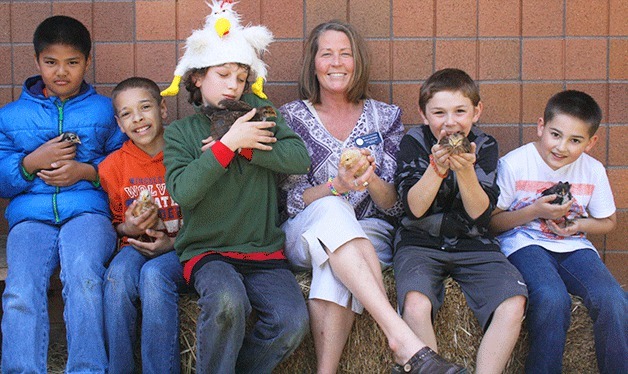An Oak Harbor elementary school is lucky enough to have fine-feathered royalty.
Miles Mumper, a fifth grader at Hillcrest, was appointed as the “chicken king” about a month ago, after Paula Seaman purchased 13 baby chicks for the school.
Mumper was placed in charge of the chickens from day one, according to Seaman, principal of Hillcrest.
“I get to take care of the chickens and choose people to come along,” Mumper said. “I tell people what to do for the chickens, and tell them, show them which is which and how they behave.
“When I come out every day, I check the water and I check their feed.”
Seaman said she purchased the chickens with her own money after deciding to do something about the smaller of the school’s two courtyards.
The larger one is used for a grant-funded project, growing vegetables, which the school will donate to the Help House.
The smaller courtyard was previously messy most of the time, so Seaman decided that a good way to keep it nicer was to get chickens.
And it turned out to be a teachable exercise.
Before the chicks moved into their new coop in the courtyard, though, they were traveled from classroom to classroom, starting with Tristy Nielsen’s second-grade class.
Nielson incorporated the chickens into her class lessons, especially for writing assignments. Her students also recorded videos with their iPads of the chickens to share at the parent teacher conferences.
“I only had really positive things from parents,” she said. “They were like, wow, this is so great that the kids are getting to do this in schools.”
The chicks stayed in Nielson’s classroom for a week. On the Friday they were to be moved to another class, Nielson said one of her students said it was the saddest day ever.
Another second-grade class and three first -grade classes “hosted” the baby chickens before they were moved outside. Meghan Trueman’s first-grade class was another temporary home for them.
Her students were learning expository writing at the time, and Trueman had her students write about the chickens.
“That was a lot of fun for the kids, to have first-hand experiences,” Trueman said. “Not just taking information from books and then writing on it, but actually being able to watch them.”
Instead of being a distraction in class, the chickens, according to Nielson, proved to be incentive for students to finish their work more quickly; when they were done, they were allowed to go watch the chickens.
Now that the chickens are outside in the courtyard, students still visit them everyday.
“Parent volunteers will come and bring groups of like, seven or eight,” Seaman said. “The kids want to see them change, because they grow so fast.”
No one expects the novelty of the chickens to wear off when the five-week-old chicks are fully grown.
“They’re still an unordinary thing to see at a school,” Mumper said. “And school has had them ever since they were a week old.”
Seaman said that the students all know which chicken is which, and they know the personalities of each. Mumper even named them based on their traits and personalities.
Rosie, Mumper’s favorite, was named because of the reddish color of her beak. Flappy is the one that likes to flap its wings a lot. Runner, the “in-building chicken,” according to Seaman, was named because he runs back and forth between the classrooms, and doesn’t like to fly as much.
Seaman has no regrets about bringing the chickens to the school.
“It’s definitely a commitment, but it’s a good move. Boost a little bit of morale, get kids excited about something,” she said.”
Mumper and fellow fifth-grader Dominic Dean both agreed that the chickens helped students stay out of trouble, since they aren’t allowed to visit the chickens otherwise.
Hayden Neff, Miles’ second-in-command chicken wrangler, said that the birds have done a lot for Hillcrest.
“One of the main things is they’ve helped other people realize that there’s more things to do,” Neff said. “It helps people become more interactive with other people, less selfish.”
Former Hillcrest teacher Mary Heck has been visiting the school a lot lately because of the chickens.
“I love it,” Heck said. “It’s just been fantastic, it really has. And this school was already a happy school; all you’ve done is just ratch it up higher.”
But the best benefit, according to Seaman, is how much it helps students learn.
“It’s not always about books,” she said. “It’s about giving kids every experience possible. And just watching those fifth-grade boys sit there and hold a chick and pet it, and just the empathy and the compassion that comes out in the kids, it’s amazing.”
The plan, according to Seaman, is to keep chickens around the school for a very long time, and keep them the happiest, “most spoiled chickens in Island County.
“They are Hillcrest, this is Hillcrest, they are part of Hillcrest.”



